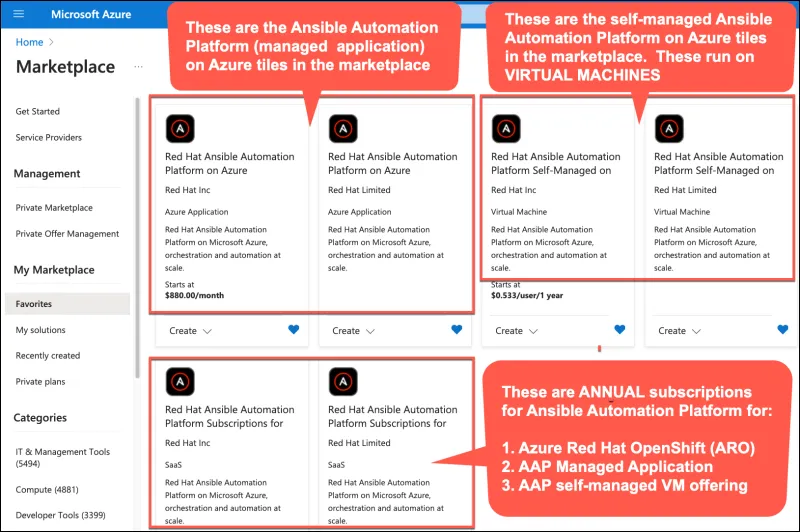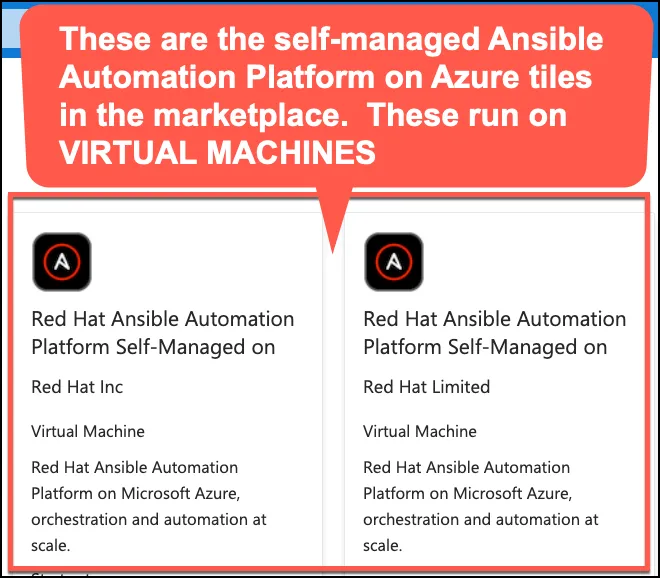In December 2023, Red Hat introduced the self-managed offering of Red Hat Ansible Automation Platform on Microsoft Azure. This new offering allows customers the flexibility to deploy Ansible Automation Platform on Azure, and customers can now choose the managed application or self-managed application in the Microsoft Azure Marketplace.
With this new Azure Marketplace listing, customers have more control over their infrastructure, the design, architecture, deployment and scalability of their Ansible Automation Platform environment. Customers can take advantage of the complete Ansible Automation Platform, including integrations with native Azure services.
Simply purchase Ansible Automation Platform t from the Azure Marketplace and self-deploy it into your Microsoft Azure tenant. You’ll also get access to Red Hat’s premium support, which counts towards your committed spend agreements with Microsoft (MACC) and integrated into Azure billing. Did we mention that Azure Government is supported for self-installed, self-managed deployments, too!
3 ways to deploy Ansible Automation Platform on Azure
There are 3 options to deploy Ansible Automation Platform on Azure. They are:
- Ansible Automation Platform on Microsoft Azure (managed application)
- Ansible Automation Platform Self-Managed on Microsoft Azure (model running on Azure virtual machines)
- Ansible Automation Platform on Microsoft Azure (self-managed model running Azure Red Hat OpenShift)

Figure 1

Figure 2
Figure 1 shows the Microsoft Azure Marketplace. Red Hat Inc, and Red Hat Limited on the marketplace tiles indicate regional distinction.
The first set of tiles (top row left) are for deploying Ansible Automation Platform on Azure as a managed application.
The second set of tiles (top row right) are for deploying Ansible Automation Platform Self-Managed on Azure for self-managed and self-installed.
The third set of tiles (bottom row) are for annual subscriptions for the following offers:
- Self-managed yearly subscription for Ansible Automation Platform on Microsoft Azure Red Hat OpenShift. Customers must already have Microsoft Azure Red Hat OpenShift
- Yearly subscription for Ansible Automation Platform on Azure (managed application)
- 1-year and 3-year subscriptions of Ansible Automation Platform Self-Managed on Azure (VM-based deployment)
NOTE: Private offers are intended and available for these annual subscription offerings (Figure 2). Please reach out to your Red Hat and/or Microsoft account executives for more information.
Let’s get into more details about Ansible Automation Platform Self-Managed on Azure.
You can choose from 3 deployment options:
Option 1: Virtual machine deployment (MSRP pricing)
For the self-manage virtual machine-based deployments, you can purchase as follows:
Purchase and deploy on your own directly from the marketplace at MSRP pricing. This is billed monthly by Microsoft

Option 2. Virtual machine deployment (annual contract)
- Review the annual contract via the Subscriptions tile. Install VMs, then deploy and manage Ansible Automation Platform on your own

Deploy Azure VMs running Red Hat Enterprise Linux from the Marketplace, then download and install Ansible Automation Platform from the Red Hat Customer Portal. Use the installation planning guide and the supported deployment models guide. Choose the number and configuration of the virtual machines depending on the architecture and size that you have determined best suits your organizational needs.
Additionally, if you want to automate the deployment (infrastructure and installation of Ansible Automation Platform), you can use this Git repository to assist you. The Ansible Content Lab is making this available (disclaimer: This is community supported and not officially supported by Red Hat or Microsoft).
https://github.com/ansible-content-lab/azure_ansible_deploymentMake your own clone of this repository so you can modify it, and trigger the installation by following the detailed instructions. Enjoy!
Option 3: Ansible Automation Platform Self-Managed on Microsoft Azure Red Hat OpenShift
- Review the annual contract via the Subscriptions tile. Purchase the subscription, and then deploy and manage Ansible Automation Platform on your own (operator-based deployment on Microsoft Azure Red Hat OpenShift).

You may choose to deploy Ansible Automation Platform on Azure Red Hat OpenShift. The deployment of Ansible Automation Platform is simple, and so is the ongoing management. Additionally, you can take advantage of the inherent capabilities of Azure Red Hat OpenShift.
Advantages of Ansible Automation Platform Self-Managed on Azure
- Architecture and scale. You get to determine what is the most ideal architecture based on your environment size and requirements—the choice is completely yours to make. For more on architecture, design, configuration and scale, please visit Ansible Automation Platform guides on Planning your installation and Tested deployment models
- Azure configuration. As a fully self-managed solution, it fits well within your organization’s Azure design and configuration
- Automation mesh support. Automation mesh is an Ansible Automation Platform feature that allows organizations to distribute automation workloads across hybrid cloud, peer-to-peer connections with each other using existing networks. Learn more about automation mesh guides
- Event-Driven Ansible is included. Event-Driven Ansible provides automation that helps you reduce manual tasks and deliver a more efficient IT environment focused on innovation. Event-Driven Ansible processes events and determines the appropriate responses, and then executes automated actions to remediate the event. Event-Driven Ansible is included with Ansible Automation Platform on Microsoft Azure offerings
What can I do next?
- Learn more about Red Hat Ansible Automation Platform on Microsoft Azure
- Learn more about Red Hat Ansible Automation Platform on other hyperscaler clouds
- Learn more about automation mesh
- Read about Event-Driven Ansible
- Practice with our hands-on self-paced labs on Ansible Automation Platform. There are labs on the following topics (and many more):
- Ansible Automation Platform on Azure
- Getting started with automation mesh
- Getting started with Event-Driven Ansible
Product trial
Red Hat Ansible Automation Platform | Product Trial
About the authors
Matthew Packer is a Principal Product Marketing Manager for Ansible Automation Platform and is responsible for cloud automation. Prior to joining Red Hat, he worked in product marketing specializing in retail payment technology at Vontier and product management at Cisco in cloud-based networking. Matthew also worked as a consultant at Honeywell in the manufacturing and utilities industries with a focus on the Internet of Things (IoT) and predictive analytics space.
Hicham is responsible for technical marketing of the Red Hat Ansible Automation Platform on Clouds. Hicham has been in the software industry for over 20 years and for many of them focused on cloud management. Hicham has been a frequent presenter at events and conferences like VMworld, vForum, VMUG, VMLive, Gartner, Dell Technology World, AWS re:Invent, HPE Discover, Cloud Field Day, Red Hat Summit, AnsibleFest, in addition to Customer events.
More like this
New efficiency upgrades in Red Hat Advanced Cluster Management for Kubernetes 2.15
Friday Five — January 16, 2026
Technically Speaking | Build a production-ready AI toolbox
AI Is Changing The Threat Landscape | Compiler
Browse by channel
Automation
The latest on IT automation for tech, teams, and environments
Artificial intelligence
Updates on the platforms that free customers to run AI workloads anywhere
Open hybrid cloud
Explore how we build a more flexible future with hybrid cloud
Security
The latest on how we reduce risks across environments and technologies
Edge computing
Updates on the platforms that simplify operations at the edge
Infrastructure
The latest on the world’s leading enterprise Linux platform
Applications
Inside our solutions to the toughest application challenges
Virtualization
The future of enterprise virtualization for your workloads on-premise or across clouds

